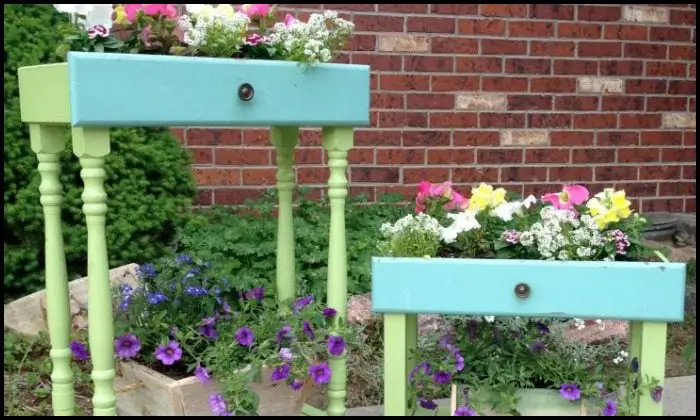Got a broken dresser or maybe you’ve seen a discarded set of drawers on the street? Those drawers can serve as beautiful planters on your porch!
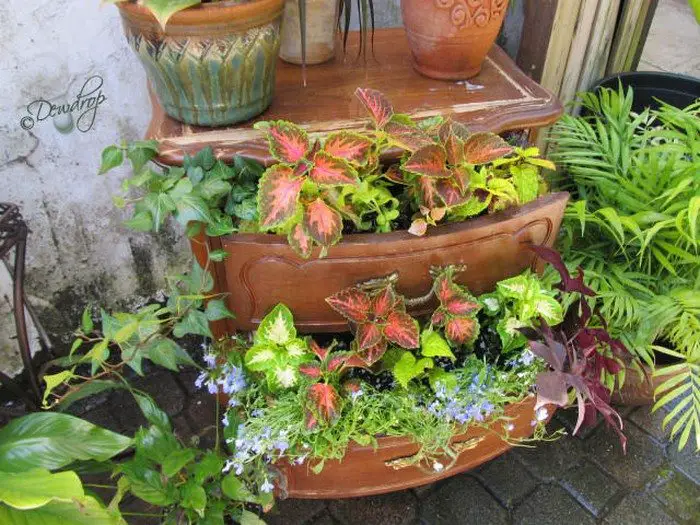
Simply restore those old drawers, add some table legs, and your porch planters are ready to accommodate your pretty blooms! You can even use an entire dresser if you have one that you aren’t using anymore.

Repaint the drawers with bright colors so they stand out in your yard. Or you can strip down old, existing paint and apply wood stain for a rustic wooden drawer planter! Your imagination and creativity is the only limit. OK, so they won’t last forever before they start to rot, but you’ll get lots of pleasure from them before that happens :)

Be inspired by viewing our gallery of old drawer planters below!
Do you want some drawer planters in your outdoor area?
Contents
Crafting Porch Planters
Materials
- Old Drawers
- Table Legs (optional)
- Paint
- Wood Stain
- Outdoor Urethane
- Wood Glue (optional)
- Potting Soil
- Plants
Tools
- Sander
- Drill
Instructions
Step 1: Prepare the Drawer
- Begin by inspecting your old drawer for any damage. Repair minor cracks or splits with wood glue, and allow it to dry completely.
- Use a sander to smooth out the surface of the drawer, focusing on removing old paint or varnish. This will prepare the wood for a new finish and ensure an even application of paint or stain.
Step 2: Modify the Drawer (Optional)
- If you plan to add table legs, flip the drawer over and mark the spots where you want the legs to be attached. Ensure the marks are evenly spaced.
- Using a drill, create holes for the legs. Attach the legs by screwing them into place or by using wood glue if the design permits.
Step 3: Apply Paint or Wood Stain
- Once your drawer is prepped and modified, apply your choice of paint or wood stain. Use a brush or roller for even coverage. For a vibrant look, choose a bright paint color; for a more natural, rustic look, apply a wood stain.
- Allow the paint or stain to dry completely, then apply a second coat if necessary for better color saturation and coverage.
Step 4: Seal with Outdoor Urethane
- To protect your planter from the elements, apply a coat of outdoor urethane over the painted or stained drawer. This will help seal the wood against moisture and sun damage.
- Allow the urethane to dry thoroughly, according to the manufacturer’s instructions.
Step 5: Prepare for Planting
- If your drawer doesn’t have them, drill drainage holes in the bottom to allow excess water to escape. This is crucial to prevent water from pooling and rotting the wood.
- Line the bottom of the drawer with a layer of gravel or small stones to improve drainage and promote healthy plant growth.
Step 6: Add Soil and Plants
- Fill the drawer with potting soil, leaving enough room to add your plants.
- Arrange your plants within the drawer, considering their height and growth pattern. Taller plants should go in the back, and shorter or cascading plants in the front.
- Once placed, fill in around the plants with additional potting soil and press down lightly to secure them.
Step 7: Maintenance
- Water your new drawer planter thoroughly after planting. Continue to water it based on the needs of the plants you’ve chosen.
- Place the planter in a location where it will receive the appropriate amount of sunlight for the types of plants you are growing.
Click on any image to start the lightbox display. Use your Esc key to close the lightbox.![]()



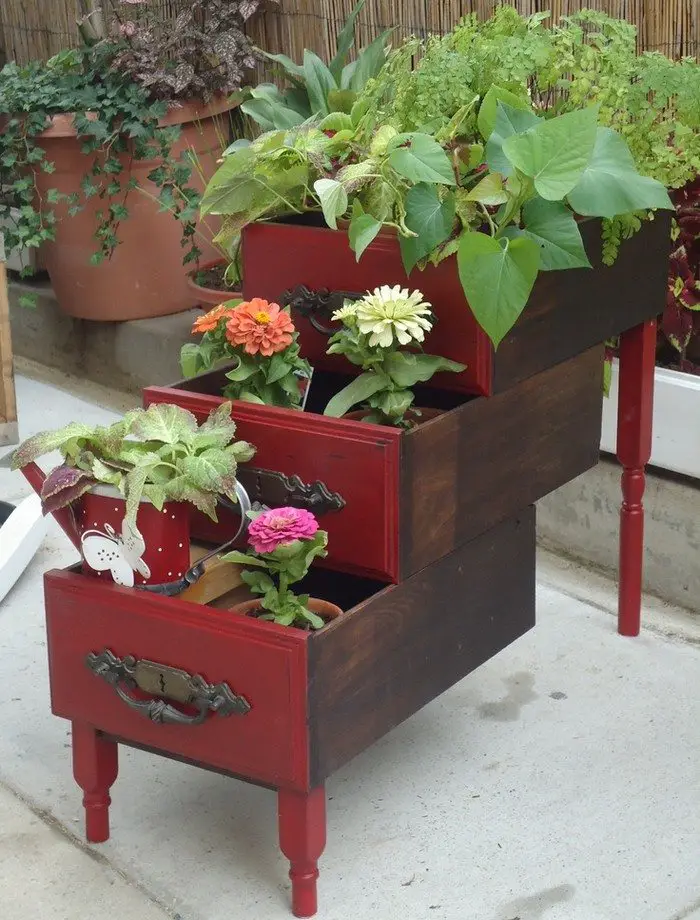

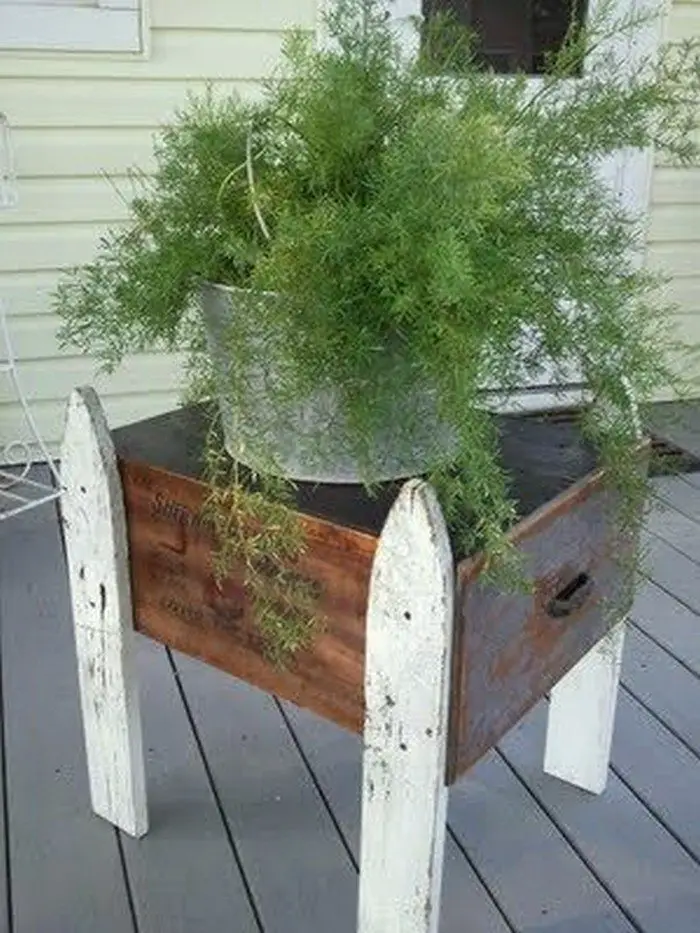
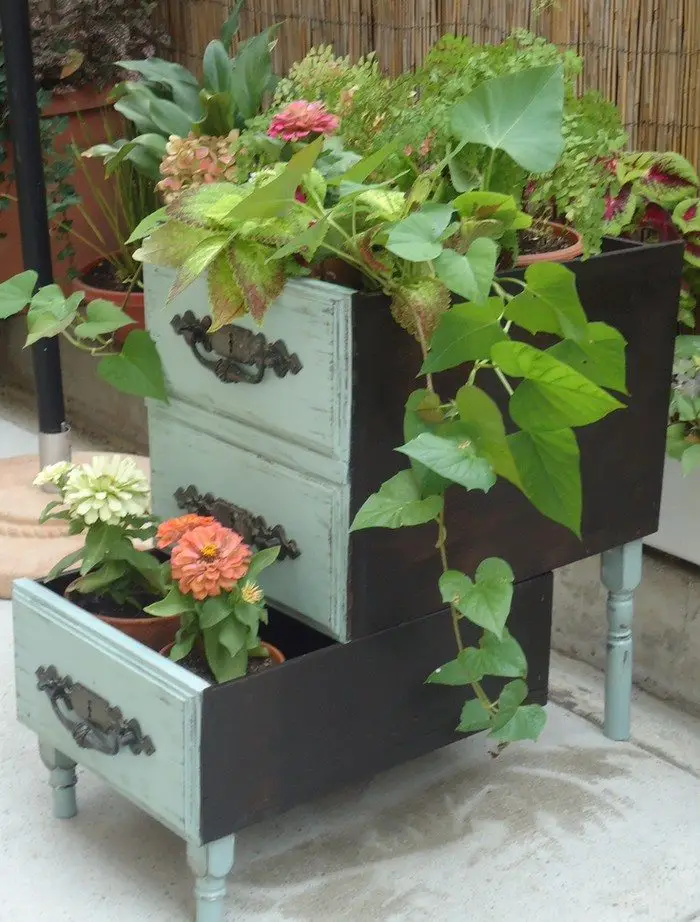


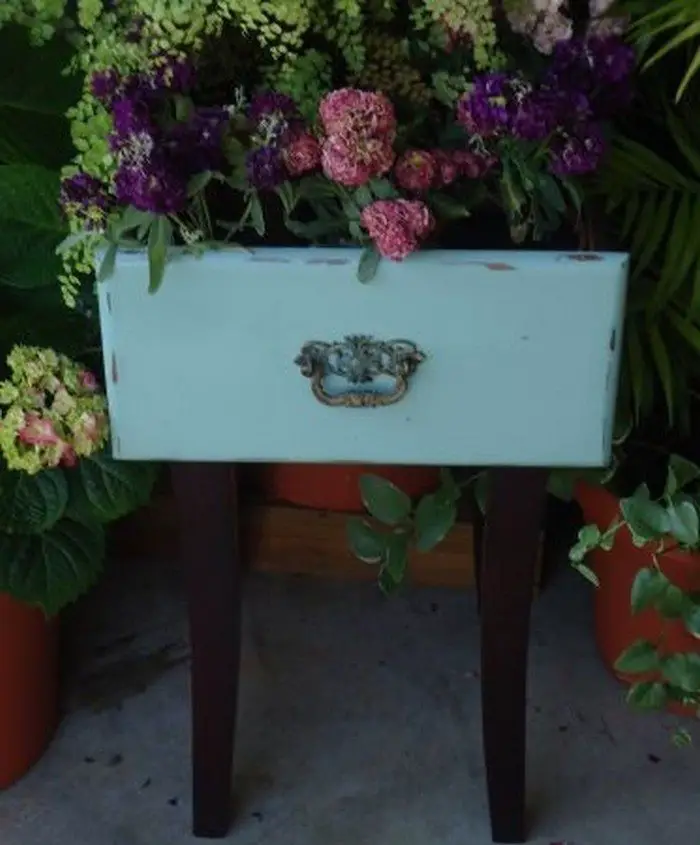
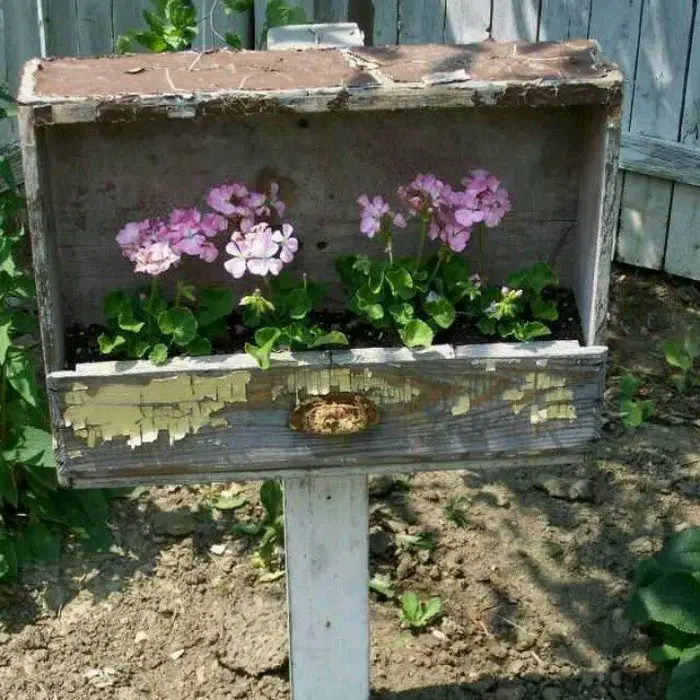
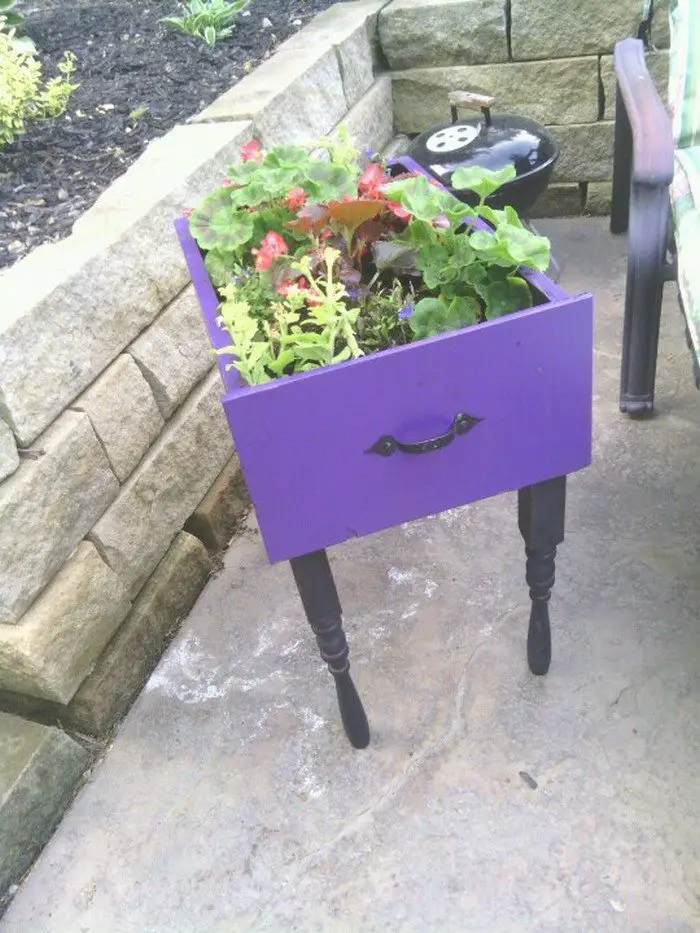
Thanks to My Love 2 Create for this great project. You can get step-by-step instructions here…
Best Plants for Drawer Planters
Choosing the right plants for your drawer planters is crucial to ensure they thrive and create an eye-catching display on your porch. Drawer planters, with their shallow depth and unique dimensions, are ideal for certain types of plants that require less root space and can handle the unique drainage conditions. Here’s a guide to the best plants that will bring life and color to your porch planters.
Succulents
Succulents are a top choice for porch planters due to their low maintenance and minimal water requirements. These resilient plants thrive in confined spaces and can handle the heat that may build up in shallow drawers. Varieties like Echeveria, Sedum, and Haworthia provide a range of colors and textures, making your porch planter a focal point of visual interest.
Herbs
Herbs are not only functional but also thrive in the limited soil depth of drawer planters. Popular choices such as basil, thyme, parsley, and chives have shallow root systems, making them perfect for porch planters. You’ll enjoy the convenience of having fresh herbs at your fingertips, and their fragrant presence will enhance the ambiance of your porch.
Annuals
Annuals are fantastic for adding vibrant color to porch planters. Petunias, marigolds, and pansies are excellent choices as they have a compact root system and flourish in full to partial sun. They also bloom profusely throughout the season, ensuring your porch planters remain lively and colorful. Remember to deadhead spent blooms to encourage continued flowering.
Perennials
For those who prefer plants that come back year after year, perennials like sedum, daylilies, and coral bells are ideal for porch planters. These plants are hardy and often have more extensive root systems, but many can adapt to the shallower environments of drawer planters. They provide lasting beauty and return each season, reducing the need for annual replanting.
Ferns
Ferns can add a lush, green look to your porch planters, especially in shaded areas. Varieties such as the maidenhair fern or Boston fern enjoy the moisture retention typical of drawer planters and can thrive with minimal sunlight. Their interesting textures and forms contrast beautifully with the straight lines of a drawer, adding visual depth to your porch display.
When planting in porch planters, always ensure good drainage to prevent waterlogging, which can harm plant roots. With the right selection of plants, your drawer planters can become an enchanting feature that enhances your porch’s aesthetic and provides you with a miniature garden to enjoy.
Weatherproofing Your Drawer Planters
Your drawer planters must be weatherproof if they are to survive the elements and keep your porch looking great for next seasons. Drawers are not meant for outdoor use, hence it is imperative to take the correct action to guard them from temperature fluctuations, sun, and moisture. To increase the lifetime of your porch planters and preserve their visual appeal, follow these guidelines for successful weatherproofing.
Seal the Wood
Sealing the wood completely comes first in weatherproofing your porch planters. A waterproof exterior urethane coat will protect the wood from rain, moisture, and humidity. Cover all surfaces, inside, exterior, and under the drawer’s bottom, for optimum effects. Apply at least two coats, with enough drying time between each one.
Improve Drainage
Correct drainage is essential to avoid water from accumulating inside your porch planters, which may cause bad plant conditions or wood rot. If they aren’t already there, drill multiple holes on the drawer’s bottom. Before adding soil, spread a layer of gravel or small stones at the drawer’s bottom to improve drainage even further. This layer keeps roots from sitting in wet and facilitates more free water flow through the soil.
Choose Weather-Resistant Paint
Select paints intended for outdoor usage if you are adding color to your porch planters. Additives in these paints fight mildew, fading, and weathering. Choose lighter hues of paint since they absorb less heat, therefore shielding the wood and plants from direct sunlight’s scorching effect. To improve the lifetime and adhesion of the paint, priming comes before painting.
Regular Maintenance
Extensive life of your porch planters depends on regular upkeep. Look for wear or damage every year, including soft areas in the wood or peeling paint that might point to rot. Sand down the impacted areas, apply fresh paint, and urethane sealing to quickly handle these problems. In the winter, also think about shifting the planters to a covered space or including a cover to guard them from strong winds.
Apply a Protective Finish
Beyond standard paint and urethane, think about using a sealant especially made for wood boats or a marine varnish. These items are perfect for shielding your porch planters from moisture and sun exposure since they have outstanding waterproofing ability and are built to resist demanding conditions.
Elevate the Planters
Rising your porch planters above the ground can help to avoid common causes of deterioration—that which results from their resting in water during heavy rain. Lift the planters with bricks, concrete blocks, or a specially built wooden stand. This not only helps with drainage but also reduces the likelihood of slugs and snails infecting your crops.
Use Anti-Rot Spacers
Put anti-rot spacers between your porch planters and the surface they rest on to help to guarantee their lifetime. By means of air circulation under the planter, these spacers help to lower moisture accumulation and stop the foundation from rotting. Small bits of rubber or PVC might make good spacers.
Reinforce with Corner Brackets
Strengthen the corners with metal brackets for increased longevity, particularly in bigger drawer planters. This helps maintain the structure stable and prevents the weight of the soil and plants from bending or splitting the wood, particularly in damp situations.
These guidelines will help you properly weatherproof your porch planters so they will be robust and colorful all year long. This not only safeguards your investment but also helps your porch to remain aesthetically pleasing.
Conclusion
Crafting porch planters from old drawers is a rewarding DIY project that combines creativity with sustainability. These unique additions to your porch not only enhance its aesthetic but also provide a functional space for growing a variety of plants. With proper preparation and weatherproofing, your handmade porch planters will thrive and bring beauty to your outdoor living area for seasons to come.
For more creative planters, check out our picture frame planter project!

